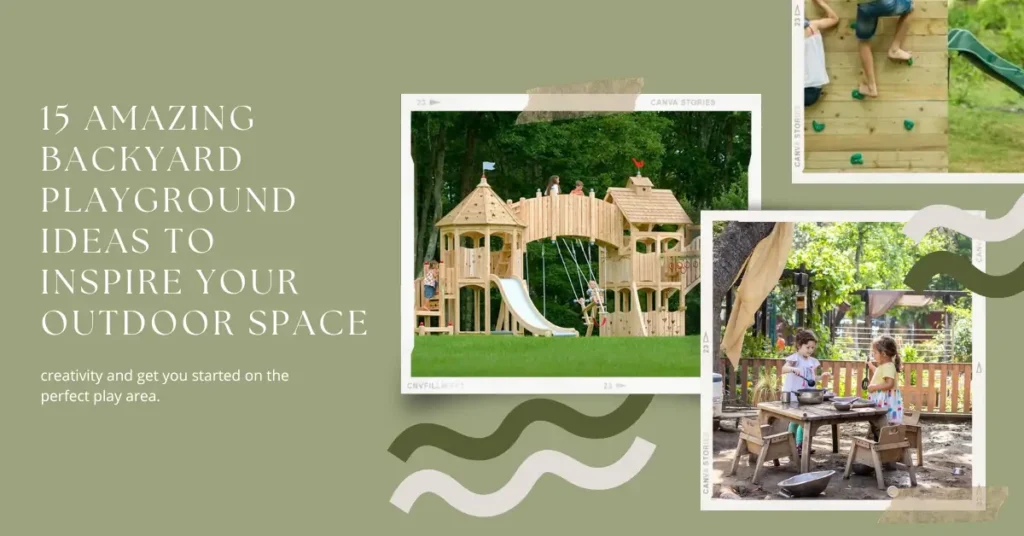Creating a fun and engaging backyard playground can be challenging. You want it to be safe, functional, and, most importantly, exciting for children. But where do you start? How do you design a space that will keep kids entertained while fitting your backyard’s aesthetics?
Don’t worry. We’ve covered you with 20 fantastic backyard playground ideas to transform your outdoor space into a haven for fun and adventure. Whether you have a small yard or plenty of space, these ideas will spark your creativity and get you started on the perfect play area.
Keep reading to discover fantastic backyard playground ideas. These suggestions will inspire you to create an outdoor space your kids will love and enjoy for years to come. From imaginative play zones to safe climbing structures, these ideas will turn your backyard into a dream playland.
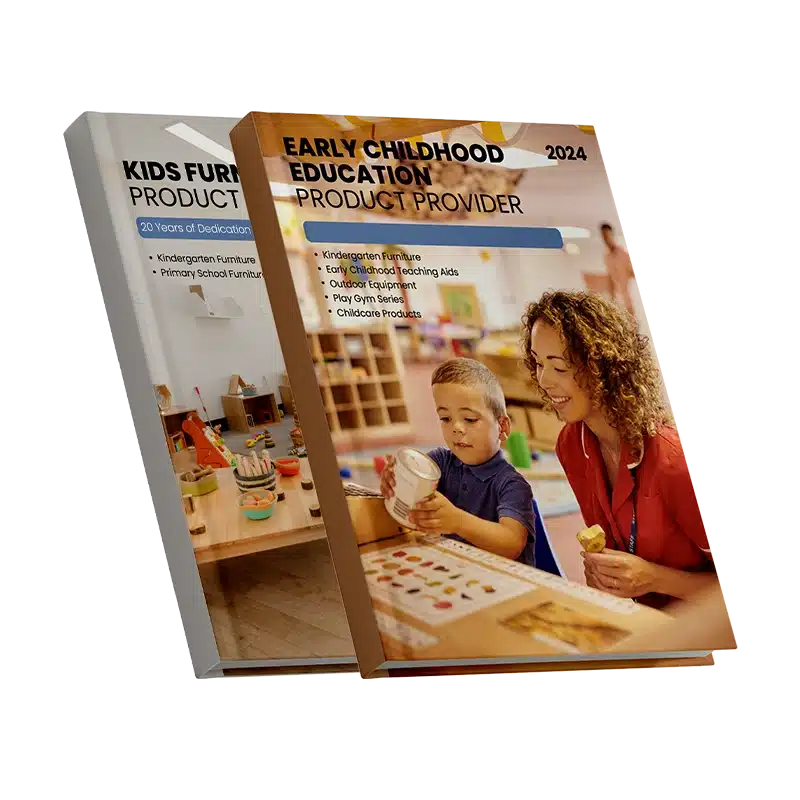
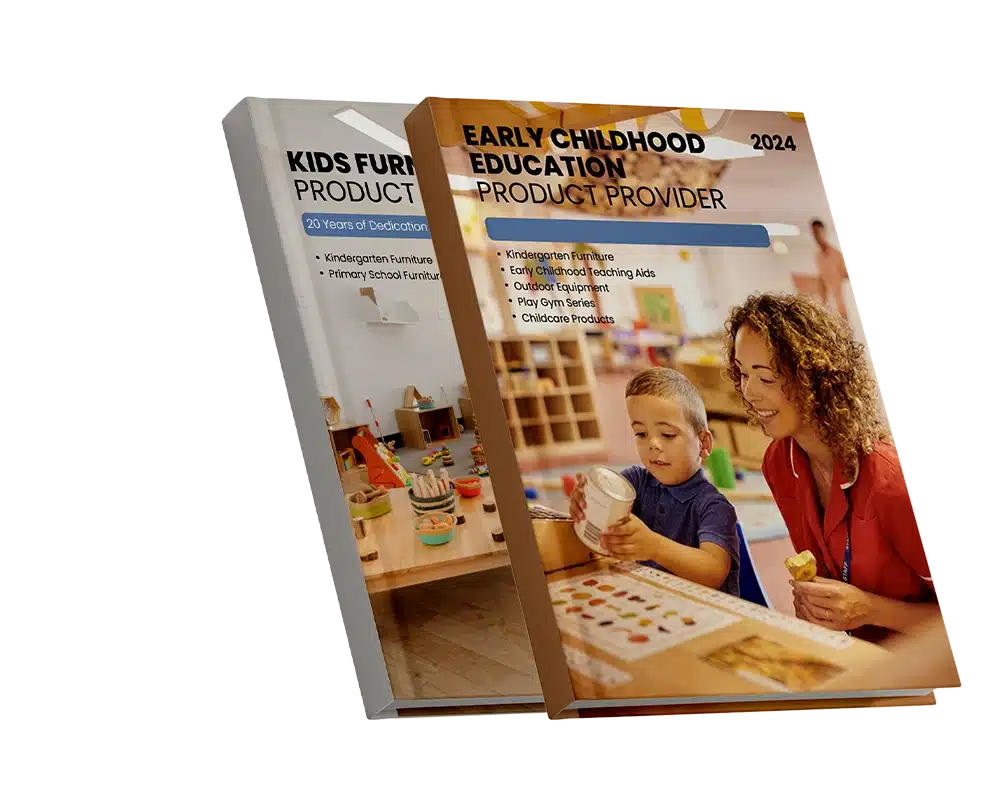
What are the best backyard playground ideas for yards of different sizes?
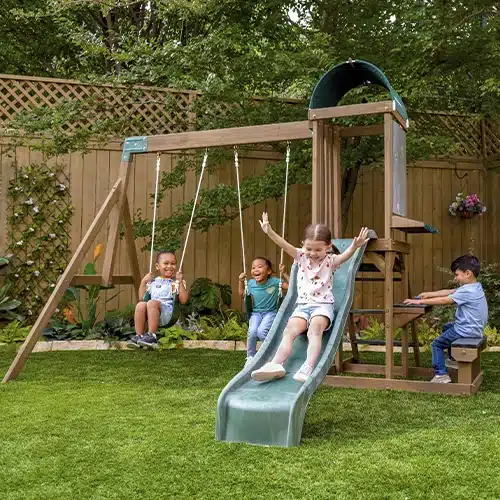
Swing Set: Swing sets can be customized with multiple swings, slides, and climbing features. They are a staple in many backyard playground ideas because they are adaptable for different yard sizes, budgets, and children’s ages. Whether made from wood or metal, they fit easily into outdoor spaces and provide a wide range of play options. Installing a swing set is often the first step in building a fun and functional backyard play area.
Benefits of swing sets in backyard playground ideas:
- Help children develop balance, coordination, and motor skills
- Encourage outdoor physical activity and reduce screen time
- Offer customizable features like monkey bars, rope ladders, and slides
- Great for all yard sizes, from compact to spacious
- Foster social interaction and imaginative play with friends or siblings
- Serve as a central feature in larger backyard playground ideas
Sandbox: A sandbox is one of the most affordable and creative additions you can make to your outdoor space. Whether it’s a classic wooden box filled with clean play sand or a modern, covered plastic model with built-in seating, sandboxes invite endless hours of open-ended play. Children can dig, build, scoop, pour, and mold — activities that naturally encourage creativity and concentration. Sandboxes can be integrated into larger backyard playground ideas, such as placed under a swing set or next to a water play table, making them a flexible and space-saving option.

Benefits of sandboxes in backyard playground ideas:
- Stimulate creativity, imagination, and sensory development
- Support early learning concepts like volume, texture, and cause and effect
- Promote independent play and peaceful solo activities
- Great for younger children, including toddlers and preschoolers
- Easily fits in small to medium backyards
- Encourages social interaction and cooperative play when shared
- Affordable and low maintenance feature for long-term use
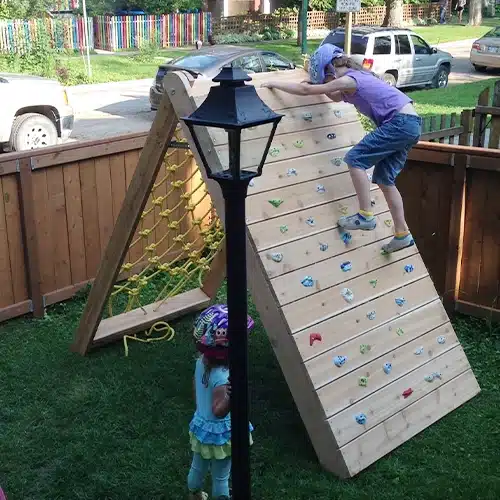
Climbing Wall: A climbing wall adds a dynamic and physically engaging feature to any outdoor play space. It encourages children to challenge themselves, solve problems, and build strength — all while having fun. Climbing walls can be simple vertical boards with colorful plastic holds, or more elaborate angled designs for older kids with varying levels of difficulty. They’re ideal as a standalone attraction or as part of a larger backyard playground idea, such as attached to a playhouse, fort, or swing set tower. Available in wood, plastic, or modular panels, they are a favorite for kids who love to move, climb, and conquer.
Benefits of climbing walls in backyard playground ideas:
- Improve physical strength, coordination, and balance
- Encourage risk-taking and self-confidence through safe challenges
- Promote problem-solving and spatial awareness
- Suitable for older children who need more advanced play options
Treehouse: A treehouse is more than just a play structure — it’s a world of imagination nestled among the branches. Whether it’s a simple platform with a ladder or a full-blown wooden fort with windows, slides, and rope bridges, a treehouse instantly transforms any backyard into a child’s adventure zone. Depending on your yard and tree availability, you can either build around an existing tree or create a freestanding elevated structure. In the world of backyard playground ideas, treehouses stand out for their blend of physical activity, imaginative play, and architectural charm.
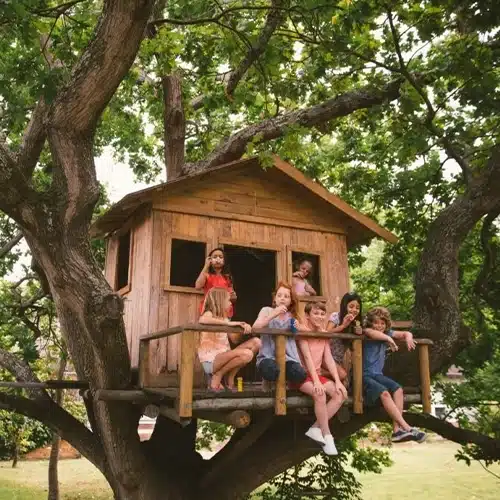
Benefits of treehouses in backyard playground ideas:
- Encourage imaginative role-playing, storytelling, and creativity
- Offer a private hideaway where children can feel independent and confident
- Promote climbing, balancing, and active play
- Can be customized with swings, slides, ladders, and bridges
- Suitable for both small and large backyards with or without mature trees
- Serve as a long-term feature that grows with the child
- Create a sense of ownership and pride in their own play space

Outdoor Playhouse: An outdoor playhouse is one of the most versatile and beloved features you can include in a backyard playground. Unlike treehouses, which are elevated, outdoor playhouses sit directly on the ground and can range from simple wooden cabins to colorful plastic cottages with working doors, windows, and even mini kitchens. They are ideal for toddlers and younger children who want a space of their own to play, imagine, and interact safely. In the world of backyard playground ideas, playhouses are perfect for role-playing and nurturing social and emotional development through pretend play.
Benefits of outdoor playhouses in backyard playground ideas:
- Support imaginative play, creativity, and storytelling
- Provide a safe, enclosed environment for toddlers and preschoolers
- Encourage social interaction through role-play and cooperative games
- Can be styled to match your backyard’s overall theme or landscaping
- Easy to install in small, medium, or large backyard spaces
- Allow year-round play with weather-resistant materials
- Serve as a calm, quiet retreat for solo play or reading
Trampoline: A trampoline is one of the most exciting additions to any backyard, instantly transforming it into a space for active, high-energy play. Whether it’s a full-size round trampoline with safety netting or a compact rectangular model for smaller spaces, trampolines offer a fun way for children to burn off energy, stay physically active, and improve their coordination. Some models even include built-in games or basketball hoops to expand the range of activities. As part of backyard playground ideas, trampolines can be freestanding or built into the ground to enhance both safety and aesthetics.
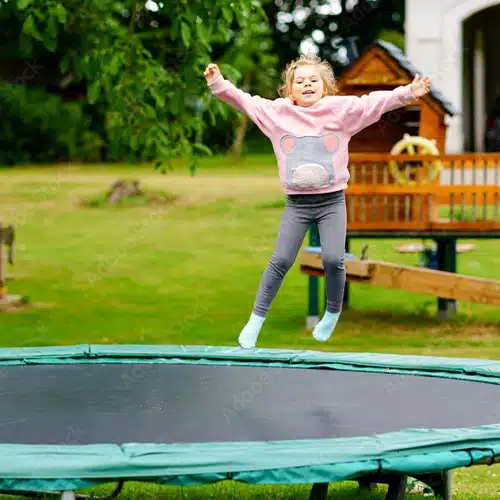
Benefits of trampolines in backyard playground ideas:
- Improve balance, coordination, and gross motor skills
- Provide a healthy outlet for high-energy movement and exercise
- Encourage outdoor activity and reduce screen time
- Suitable for a wide age range, from preschoolers to teens
- Can be customized with safety enclosures, padding, and accessories
- Fit into both small and large backyards, depending on the model
- Support group play and social interaction through shared games
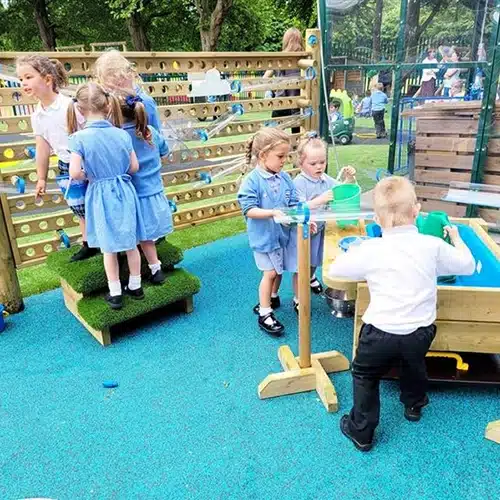
Water Play Area: A trampoline is one of the most exciting additions to any backyard, instantly transforming it into a space for active, high-energy play. Whether it’s a full-size round trampoline with safety netting or a compact rectangular model for smaller spaces, trampolines offer a fun way for children to burn off energy, stay physically active, and improve their coordination. Some models even include built-in games or basketball hoops to expand the range of activities. As part of backyard playground ideas, trampolines can be freestanding or built into the ground to enhance both safety and aesthetics.
Benefits of trampolines in backyard playground ideas:
- Improve balance, coordination, and gross motor skills
- Provide a healthy outlet for high-energy movement and exercise
- Encourage outdoor activity and reduce screen time
- Suitable for a wide age range, from preschoolers to teens
- Can be customized with safety enclosures, padding, and accessories
- Fit into both small and large backyards, depending on the model
- Support group play and social interaction through shared games
Obstacle Course: An obstacle course is an exciting way to turn your backyard into a space that challenges both the body and the mind. Whether built with wooden balance beams, rope tunnels, climbing nets, stepping stones, or even hula hoops and cones, a DIY or modular obstacle course can be adapted to suit various ages and skill levels. It encourages kids to move in different ways — crawling, climbing, jumping, and balancing — making it one of the most comprehensive features in many backyard playground ideas.
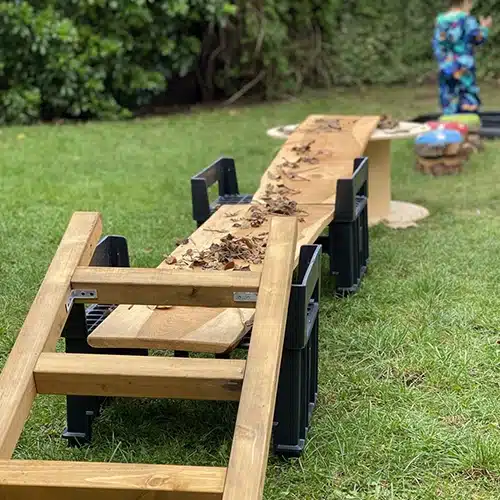
Benefits of obstacle courses in backyard playground ideas:
- Develop strength, agility, coordination, and spatial awareness
- Foster problem-solving skills and persistence
- Encourage teamwork and cooperation during group play
- Easily customized for different ages, themes, or backyard sizes
- Provide endless variety to keep kids engaged and challenged
- Combine physical activity with imaginative adventure scenarios
- Great for hosting birthday parties or outdoor group activities
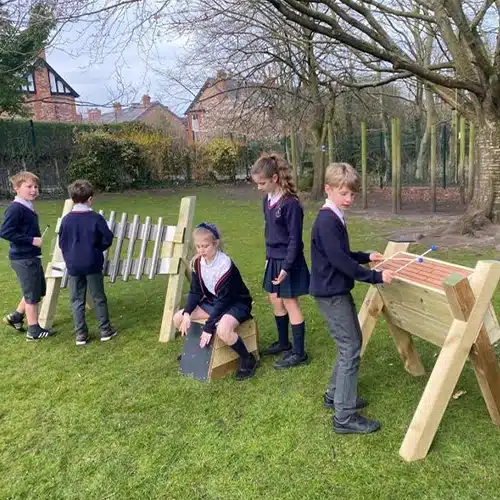
Musical Instruments: Outdoor musical instruments bring sound, rhythm, and creativity into your child’s play environment. From metal chimes and outdoor drums to xylophones and sound walls made from recycled materials, musical play stations are a unique way to stimulate auditory senses and encourage expressive movement. These features are perfect for younger children, especially in Montessori or Reggio-inspired settings, where sensory exploration is a core learning component.
Benefits of musical instruments in backyard playground ideas:
- Stimulate auditory development and musical curiosity
- Encourage creativity, rhythm, and self-expression
- Promote fine motor skills through tapping, drumming, and striking
- Suitable for children of all ages and abilities
- Enhance sensory play zones within the backyard
- Create a calming, peaceful area for relaxation and mindfulness
- Easy to integrate using weather-resistant, durable materials
Zip Line: A backyard zip line is the ultimate thrill for kids who love speed, movement, and adventure. It turns an ordinary backyard into an exhilarating outdoor playground. Designed with a sturdy cable, a secure trolley, and safety harnesses or seats, zip lines can be installed between two trees or with support posts if trees aren’t available. They’re especially appealing to older children and pre-teens who crave more exciting, high-energy play. In terms of backyard playground ideas, zip lines offer a unique way to promote active fun, build confidence, and make your outdoor space truly unforgettable.
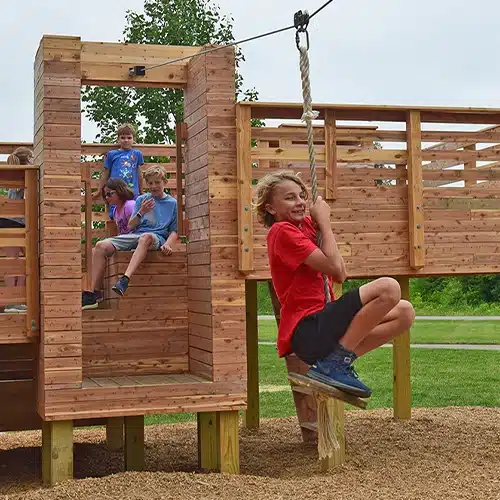
Benefits of zip lines in backyard playground ideas:
- Provide a high-adrenaline experience that’s safe and structured
- Build confidence and encourage kids to overcome fear
- Improve grip strength, balance, and upper body coordination
- Add variety and movement to traditional backyard setups
- Can be customized for different age levels and yard sizes
- Encourage outdoor play for older children and siblings
- Serve as a unique focal point in a well-rounded backyard playground
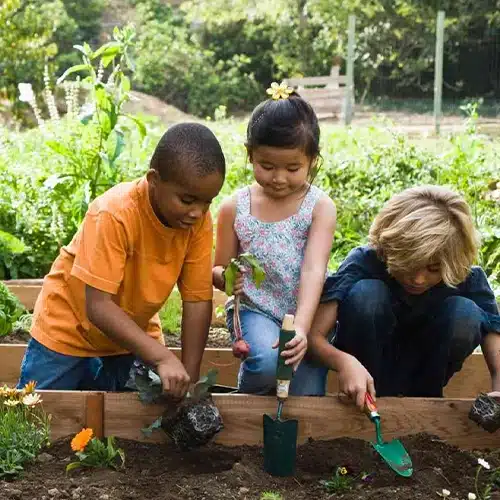
Garden Area: A garden area might not seem like a traditional playground element, but it offers countless developmental and emotional benefits for young children. Whether it’s a vegetable patch, a flower bed, or a row of sensory plants, garden spaces introduce kids to nature in a hands-on, interactive way. They learn responsibility by watering, patience by waiting for plants to grow, and curiosity through observing bugs, roots, and soil. As part of thoughtful backyard playground ideas, a garden area can be sectioned off with raised beds, logs, or even child-sized tools to create a welcoming, child-friendly mini eco-system.
Benefits of garden areas in backyard playground ideas:
- Foster responsibility and patience through hands-on planting
- Encourage observation, exploration, and environmental awareness
- Promote sensory development with textures, smells, and colors
- Offer a calm, therapeutic space for quiet play and mindfulness
- Support life science education in a fun, real-world setting
- Suitable for all backyard sizes and can be scaled up or down
- Easy to integrate with natural play areas or outdoor classrooms
Sports Zone: A sports zone brings energy, competition, and teamwork into your backyard. Whether it’s a mini soccer field, a basketball hoop, a badminton net, or a multi-use space with artificial turf for various ball games, a sports zone is perfect for kids who love structured physical activity. These areas can be easily customized based on your child’s favorite sport and the size of your backyard. In many backyard playground ideas, a sports zone serves as a space for exercise, skill-building, and healthy peer interaction. It can be designed with portable equipment or permanent installations, making it a flexible addition to your outdoor setup.
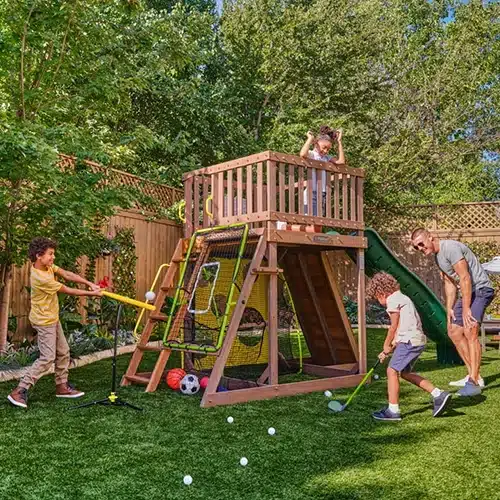
Benefits of sports zones in backyard playground ideas:
- Promote fitness, strength, and coordination through active play
- Support team-based games that build social and communication skills
- Help develop discipline, strategy, and goal-setting habits
- Adaptable for different sports and changing interests
- Suitable for older children and teens who want more challenging activities
- Encourage regular outdoor movement and reduce screen time
- Ideal for family bonding through shared games and activities
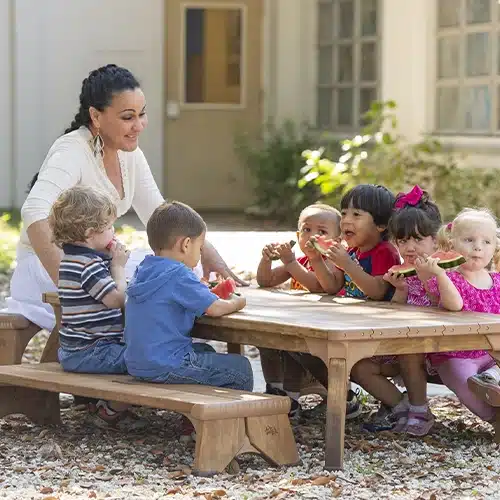
Picnic Area: A picnic area might not involve climbing or sliding, but it plays an essential role in balancing active play with calm, quality time outdoors. It becomes the heart of your backyard playground ideas when used thoughtfully. Whether you choose a kid-sized picnic table, a full outdoor dining set for the whole family, or a simple blanket under a shady tree, a picnic zone offers a place to rest, eat, create, and bond.
Beyond the basics, you can incorporate themed tablecloths, sensory baskets, or mini chalkboards for creative engagement.
Benefits of picnic areas in backyard playground ideas:
- Provide a comfortable space for resting and snacking between activities
- Encourage social bonding and family interaction outdoors
- Useful for outdoor crafts, reading, journaling, or homeschool sessions
- Help structure outdoor time with natural “break” zones
- Suitable for all backyard sizes, using foldable or built-in furniture
- Combine well with other features like shade trees, pergolas, or garden beds
- Promote mindfulness, calmness, and emotional reset during active play
Art Station: An outdoor art station brings imagination to life — with paintbrushes, chalk, watercolors, and nature as the canvas. It’s an essential feature for families or kindergartens looking to blend creativity with fresh air. Whether you set up a simple easel under a tree, install a chalkboard wall along your fence, or build a weatherproof table with paint trays and storage, an art station transforms your outdoor space into a creative zone for self-expression and fine motor development. As part of well-rounded backyard playground ideas, art stations encourage children to experiment, express feelings, and engage with the natural world through color, shape, and texture.
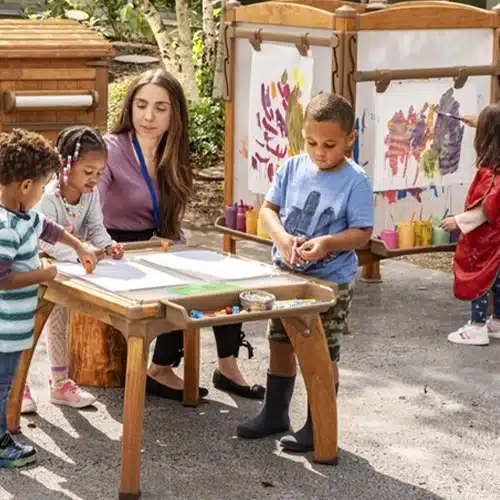
Benefits of art stations in backyard playground ideas:
- Encourage creativity, imagination, and self-expression through open-ended activities
- Support fine motor skill development (cutting, drawing, brushing, gripping)
- Offer a calming, focused activity that contrasts with physical play
- Allow children to explore materials from nature in their artwork
- Adaptable for toddlers, preschoolers, and older children
- Suitable for small or large outdoor areas, with minimal setup required
- Integrate well with educational approaches like Montessori and Reggio Emilia
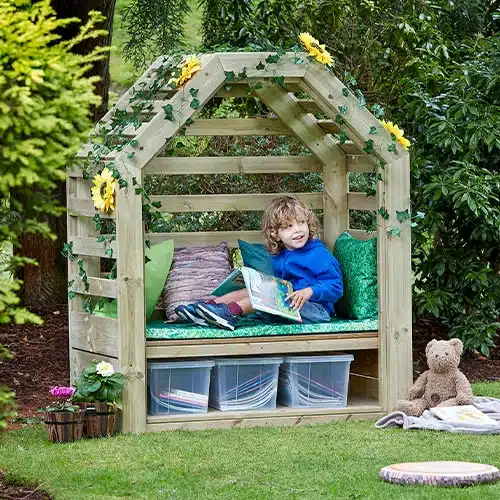
Quiet Nook: Amid all the fun and energy of a backyard play space, children also need a place to slow down, reflect, and feel safe — and that’s where a quiet nook becomes essential. A quiet nook is a small, sheltered area specifically designed for rest, mindfulness, reading, or quiet solo play. It can be as simple as a hammock strung between trees, a tent-style canopy filled with cushions, or a wooden bench tucked under a shady corner with soft pillows and books. In thoughtfully planned backyard playground ideas, quiet nooks provide the emotional and sensory balance children need during their outdoor time.
Benefits of quiet nooks in backyard playground ideas:
- Provide a safe, calming space for emotional regulation and downtime
- Encourage mindfulness, self-awareness, and personal reflection
- Support independent reading and quiet play activities
- Help reduce overstimulation in active play environments
- Ideal for children with different sensory needs or personalities
- Can be created with minimal space using natural, soft materials
- Promote emotional development as part of holistic outdoor play
Freestanding Stools and Chair:Freestanding stools and chairs may seem like minor additions, but they add essential versatility, comfort, and structure to any outdoor play space. Unlike fixed benches or picnic tables, these movable seats can be repositioned anywhere — around a sandbox, beside a garden bed, in a reading corner, or even as part of an outdoor classroom. They allow children to create their own space, foster independence, and accommodate a variety of activities. In thoughtfully designed backyard playground ideas, freestanding stools and chairs provide dynamic seating options that grow and adapt with the child’s needs.

Benefits of freestanding stools and chairs in backyard playground ideas:
- Offer flexible, movable seating for various activities
- Encourage independence and self-directed space creation
- Support outdoor learning, art, and snack time with ease
- Suitable for children of all ages with age-appropriate designs
- Can be used in multiple areas: reading nooks, gardens, art stations
- Lightweight and easy to store or rearrange as needed
- Enhance the functionality and flow of backyard learning/play zones

Children’s Outdoor Welly Store Classroom: In any outdoor learning or play environment, keeping things clean, dry, and organized is essential — especially when it comes to muddy boots and wet gear. That’s where a Children’s Outdoor Welly Store comes in. Whether you’re running a backyard classroom, managing a kindergarten, or creating a weather-friendly play zone at home, a welly store offers the perfect solution for storing boots, raincoats, and waterproof clothing. It keeps muddy shoes off play surfaces, prevents clutter, and teaches children responsibility for their belongings — all of which are key to successful backyard playground ideas.
Benefits of welly stores in backyard playground ideas:
- Promote cleanliness and organization in outdoor play environments
- Encourage independence as children manage their own belongings
- Help prevent slips, mess, and cross-contamination inside learning areas
- Suitable for year-round use in all climates
- Ideal for kindergartens, early years centers, and nature-based classrooms
- Easily paired with other outdoor stations (handwashing, mud kitchens)
- Made from weatherproof materials for long-lasting durability
Wooden Shelving Unit:A wooden shelving unit may seem like a storage solution at first glance, but in well-designed backyard playground ideas, it becomes much more — a foundation for order, independence, and accessibility. Whether you’re running a backyard daycare, managing a kindergarten outdoor space, or building a child-centered home play area, having open, child-height shelves helps keep outdoor materials organized and in constant, independent reach for kids. From art supplies and gardening tools to water toys and natural materials like stones or pinecones, everything has its place — just as Montessori philosophy encourages.

Benefits of wooden shelving units in backyard playground ideas:
- Promote independence by allowing children to access materials themselves
- Encourage responsibility and organization through cleanup routines
- Keep outdoor tools, toys, and learning materials visible and accessible
- Support themed activity zones like art, science, or gardening
- Blend seamlessly with Montessori or Reggio-inspired environments
- Built from natural materials, enhancing aesthetic harmony with nature
- Help maintain a clutter-free, functional outdoor learning/play space

Activity Panels: Activity panels are one of the most underrated yet powerful tools in any well-planned backyard playground ideas setup. These panels are designed with built-in educational and sensory games that engage children’s minds as much as their bodies. From spinning gears and alphabet mazes to bead sliders, mirror games, tactile textures, and even magnetic shapes, activity panels turn a wall or fence into an interactive learning zone. They’re ideal for toddlers and preschoolers, especially in Montessori or Reggio-inspired environments where self-directed, hands-on discovery is central to development.
Benefits of activity panels in backyard playground ideas:
- Stimulate cognitive development through problem-solving and matching games
- Encourage fine motor skill development with buttons, gears, and sliders
- Support sensory play with textures, colors, and interactive movement
- Easy to install on existing structures or as freestanding features
- Suitable for inclusive and accessible play for all abilities
- Ideal for small yards with limited space for larger structures
- Align perfectly with Montessori and Reggio Emilia learning philosophies
Divided Rooms:“Divided rooms” refer to the intentional zoning of different activity areas within an outdoor space — a core principle in high-quality backyard playground ideas. Instead of a single, open yard where all types of play happen together (and often collide), dividing your backyard into distinct “rooms” brings both order and clarity. These zones might include a quiet reading nook, a messy art station, a climbing and gross-motor area, and a sensory or nature-based space. Using low fencing, planter boxes, garden borders, wood logs, stepping stones, or even rugs and mats, you can visually and physically separate spaces without building permanent walls.

Benefits of divided rooms in backyard playground ideas:
- Promote focused, purposeful play by separating different activities
- Help children self-regulate and make clear choices in play
- Reduce overstimulation by organizing play into manageable zones
- Reflect educational best practices used in classroom environments
- Easy to implement using natural or modular dividers
- Allow educators or parents to supervise areas more effectively
- Make the overall backyard space feel larger, safer, and more intentional
How can I ensure safety in my backyard playground?
Ensuring safety in your backyard playground involves selecting quality equipment, providing adequate supervision, and maintaining the play area regularly. Here are several ways to make your backyard playground a safe environment for children:
- Choose Certified Equipment: Always use playground equipment that meets safety standards and certifications. This ensures that the equipment has been tested for safety and durability. Look for reputable manufacturers that provide clear safety guidelines and product certifications.
- Regular Inspections: Inspect all playground equipment for wear and tear, loose bolts, or sharp edges. Address any issues immediately to prevent accidents. A well-maintained playground is crucial for preventing injuries.
- Soft Landing Surfaces: Use soft landing surfaces like rubber mulch, sand, or foam mats under climbing structures and swings. These materials help cushion falls and reduce the risk of injuries. Avoid hard surfaces like concrete or asphalt in play areas.
- Proper Installation: Ensure all playground equipment is installed correctly according to the manufacturer’s instructions. Improper installation can lead to instability and increase the risk of accidents. Hire a professional to install larger structures like swing sets or climbing walls if necessary.
- Adequate Supervision: Always supervise children while they are playing. Even with the safest equipment, accidents can happen. Keeping an eye on children helps to prevent risky behaviors and ensures quick response in case of an accident.
- Educate Children: Teach children how to use the playground equipment safely. Encourage them to take turns, avoid pushing or shoving, and use equipment as intended. Education is a critical component in ensuring playground safety.

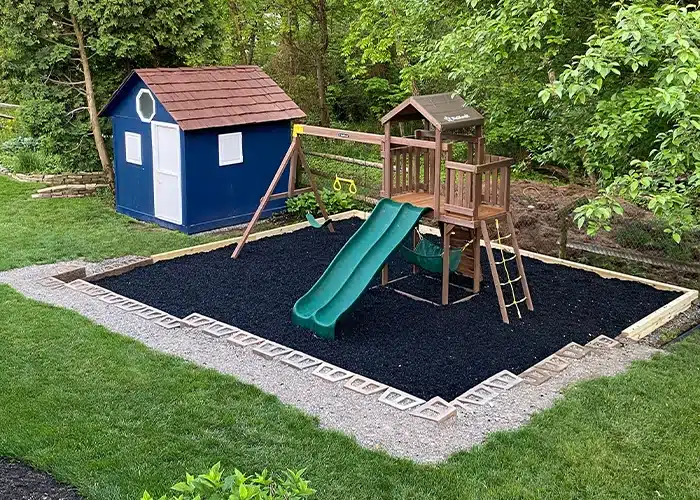
How can I make my backyard playground suitable for all ages?
Creating a backyard playground that caters to children of various ages requires thoughtful planning and multiple features. Here are some backyard playground ideas to ensure your space is engaging, safe, and fun for everyone.
First, consider diverse equipment that meets the needs of different age groups. For toddlers, include low-to-the-ground structures like small slides, sandboxes, and swings with safety harnesses. These features allow younger children to play safely and develop their motor skills. You can add more challenging elements for older kids, such as climbing walls, taller slides, and monkey bars. This variety ensures that children of all ages can find something enjoyable and age-appropriate.
Incorporating adjustable features is another compelling backyard playground idea. Equipment that can grow with your children, such as height-adjustable swings and scalable climbing walls, offers long-term value and continued interest. This adaptability means that as your children age, the playground can evolve to meet their changing needs and abilities, keeping them engaged and active.
Creating separate play areas within your backyard playground is an intelligent strategy to accommodate different age groups. Designate zones for toddlers, preschoolers, and older children to prevent conflicts and ensure safety. For example, a quiet corner with a sandbox and small playhouse for younger kids and a more dynamic area with climbing structures and sports equipment for older children. This separation helps maintain order and allows kids to play freely within their comfort zones.
Consider multi-functional spaces as part of your backyard playground ideas. These areas can serve multiple purposes and be enjoyed by children of various ages. An ample open space can be used for sports, running, or setting up temporary activities like obstacle courses. Similarly, a shaded picnic area can double as a craft station or reading nook, providing a versatile environment that adapts to different activities and interests.
Inclusive design is essential for making your backyard playground suitable for all ages and abilities. Ensure the playground is accessible by including ramps, wide pathways, and sensory play equipment. This consideration ensures that children with disabilities can enjoy the playground alongside their peers. Features like tactile boards, musical instruments, and water play areas add sensory-rich experiences that benefit all children.
Finally, incorporate engaging themes to captivate children’s imaginations and encourage creative play. Themes like pirate ships, castles, or jungle adventures can appeal to a wide age range and inspire hours of fun. Themed play areas provide a cohesive look and feel to your backyard playground, making it a magical place where kids of all ages can explore and play together.
By implementing these backyard playground ideas, you can create a versatile, engaging, and safe outdoor space that caters to children of all ages. The key is to mix age-appropriate equipment, adjustable features, and inclusive design to ensure every child finds joy and adventure in your backyard playground.
Types of Equipment
When selecting equipment for your backyard playground, it’s essential to consider age-appropriateness. Children of different ages have varying needs and abilities, and the equipment should reflect these differences to ensure safety and enjoyment for all.
Ages 2 to 5
For younger children, equipment should be safe, accessible, and engaging. A playground for this age group might include:
- Age-Appropriate Climbing Opportunities: Kids at this stage are developing their climbing skills, so climbing structures should be low to the ground and feature soft materials to prevent injuries.
- Shorter Slides: Slides are a favorite among young children. They should be shorter and less steep, allowing kids to enjoy them safely.
- Sensory Activities: Sensory play engages children’s senses and aids their development. Include sandboxes, water tables, or playground pieces with musical or tactile elements to stimulate sight, touch, and hearing.
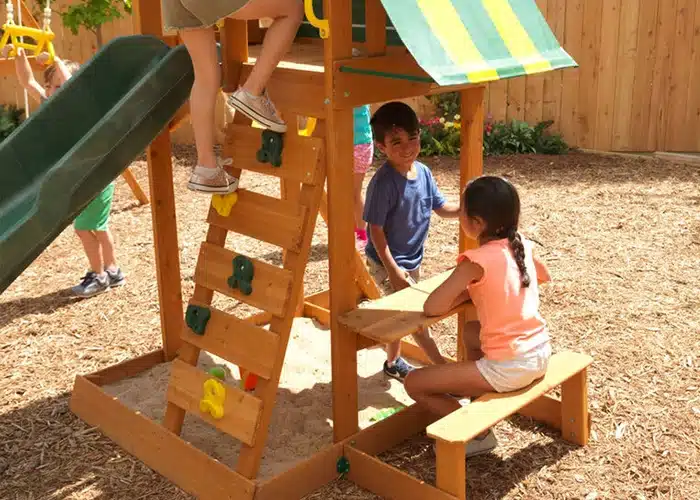

Ages 5 to 12
Older children require more challenging equipment for their advanced physical and cognitive development. Consider the following:
- Taller Equipment: Equipment should be larger and more complex to keep school-aged children engaged. Taller ladders, higher slides, and climbing walls can provide the physical challenges they enjoy.
- More Challenging Activities: Activities that test their growing skills are ideal. Monkey bars, balance beams, and obstacle courses are excellent for developing strength, coordination, and agility.
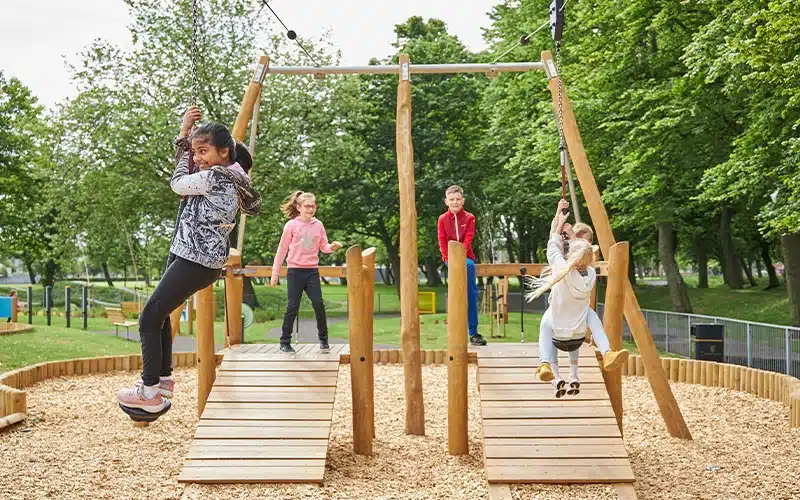
All Ages
To create a playground suitable for a wide range of ages, consider incorporating:
- Multi-Functional Structures: Playsets that combine elements like swings, slides, and climbing areas can simultaneously cater to different age groups.
- Adjustable Equipment: Choose equipment that can be adjusted as children grow, such as height-adjustable swings or scalable climbing walls.
- Inclusive Design: Ensure the playground is accessible to children of all abilities. Incorporate ramps, wide pathways, and equipment usable for children with disabilities.
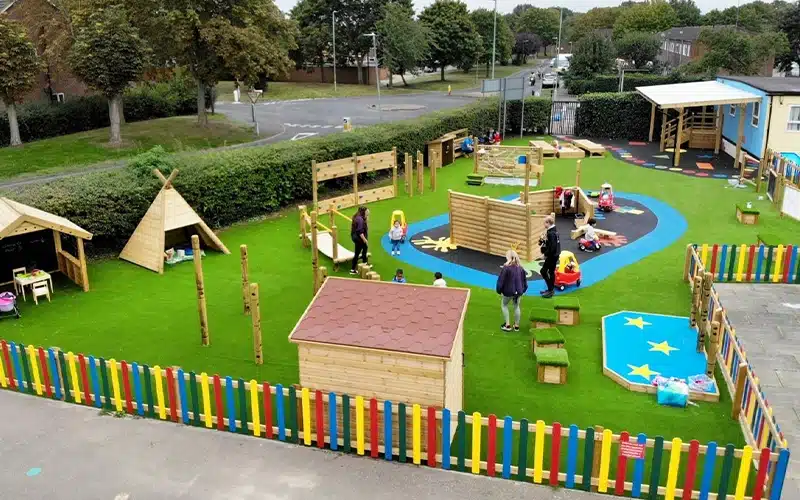
What Materials Are Best For Building a Backyard Playground?
Choosing suitable materials is crucial for building a durable, safe backyard playground. Here are some recommended materials and their benefits:
- Treated Wood: Treated wood is a popular playground choice due to its natural appearance and durability. It is resistant to decay and insects, making it suitable for outdoor use. However, ensure that the wood is treated with non-toxic preservatives to prevent harmful chemicals from leaching into the soil.
- High-Quality Plastic: Plastic materials are often used for slides, swing seats, and other components due to their durability and ease of maintenance. High-quality plastic is resistant to weathering and doesn’t splinter, making it a safe choice for children. Look for UV-resistant plastics to prevent fading and cracking.
- Metal: Metal is used for structural components like swing frames and climbing structures because of its strength and durability. Galvanized or powder-coated metal resists rust and corrosion, ensuring the longevity of the equipment. However, metal can become hot in direct sunlight, so consider shading or insulating exposed metal parts.
- Rubber: Rubber is commonly used for safety surfaces and impact-absorbing mats. Recycled rubber mulch and tiles provide excellent shock absorption and reduce the risk of injury from falls. Rubber surfaces are slip-resistant and easy to maintain, making them ideal for high-traffic play areas.
- Composite Materials: Composite materials, which combine wood fibers and plastic, offer the aesthetic appeal of wood with the durability and low maintenance of plastic. These materials are resistant to splintering, warping, and fading, making them an excellent choice for playground decking and other structural elements.
- Fabric and Netting: Fabric canopies and shade sails provide essential sun protection, keeping play areas cool and reducing the risk of sunburn. Heavy-duty netting is used for climbing nets and safety barriers, offering flexibility and strength. These materials add safety and comfort to the playground environment.
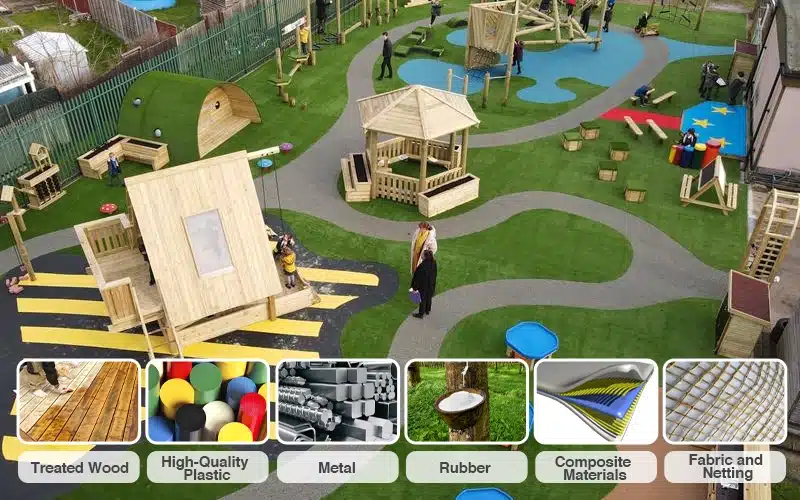
How Do I Incorporate Nature Into My Backyard Playground?
Incorporating natural elements into your backyard playground can enhance its aesthetic appeal and provide a more enriching play experience. Here are some ways to integrate nature into your playground design:
- Natural Landscaping: Use trees, shrubs, and flower beds to create a natural landscape around the playground. Planting native species provides shade, improves air quality, and provides local wildlife habitat. Ensure that the plants you choose are non-toxic and safe for children.
- Garden Areas: Dedicate a portion of the playground to a garden where children can plant flowers, vegetables, or herbs. Gardening teaches children about nature, responsibility, and where food comes from. Raised garden beds or container gardens are ideal for smaller spaces and are more accessible for children to manage.
- Natural Play Structures: Incorporate natural materials like logs, boulders, and tree stumps into the playground design. These elements can be climbing structures, balance beams, or seating areas. Natural play structures blend seamlessly with the environment and encourage imaginative play.
- Water Features: Adding a water feature like a small pond, stream, or water table can provide a sensory-rich play experience. Water play helps children develop fine motor skills and understand the properties of water. Ensure that any water feature is shallow and supervised to maintain safety.
- Sand Play Areas: Sandboxes or sand pits offer a versatile play space where children can dig, build, and explore. Sand play encourages creativity and sensory development. Cover the sandbox when not used to keep the sand clean and debris-free.
- Natural Pathways: Create pathways using natural materials like wood chips, gravel, or stepping stones. These paths can lead to different play areas and encourage exploration. Natural pathways add texture and visual interest to the playground.
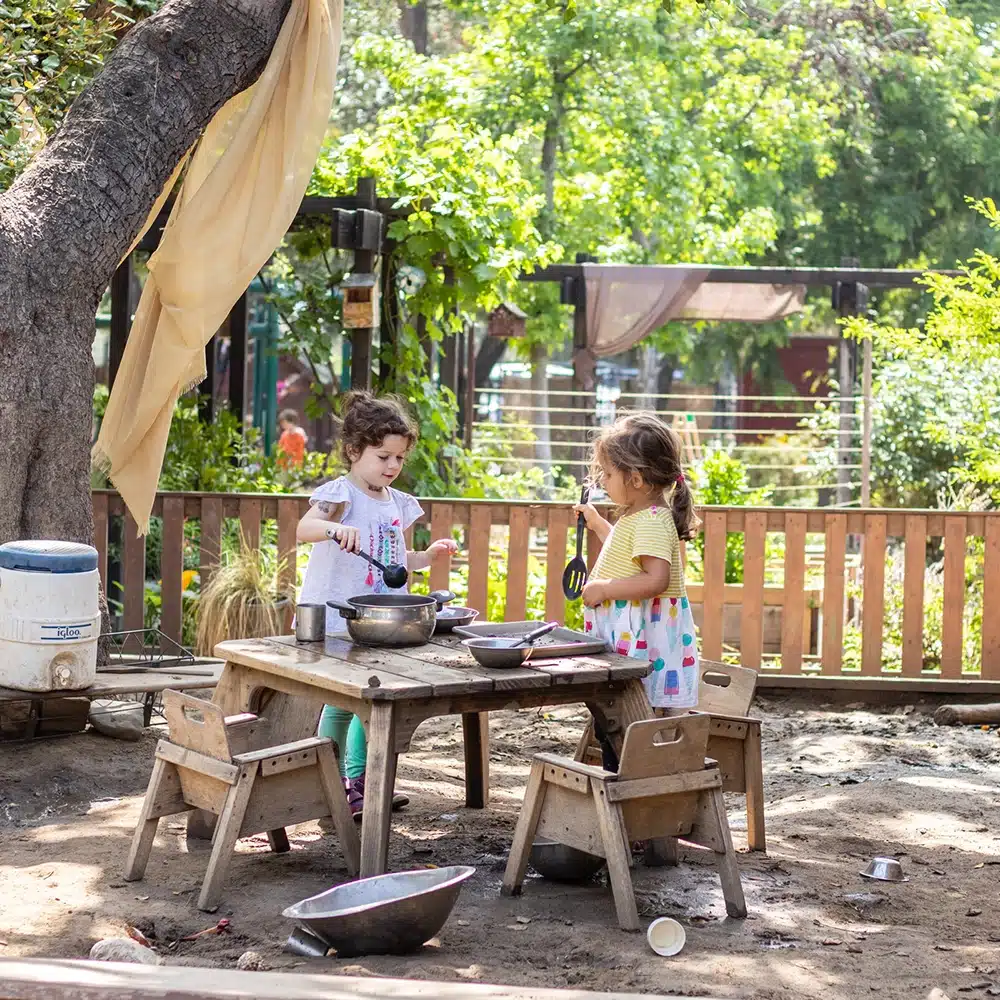
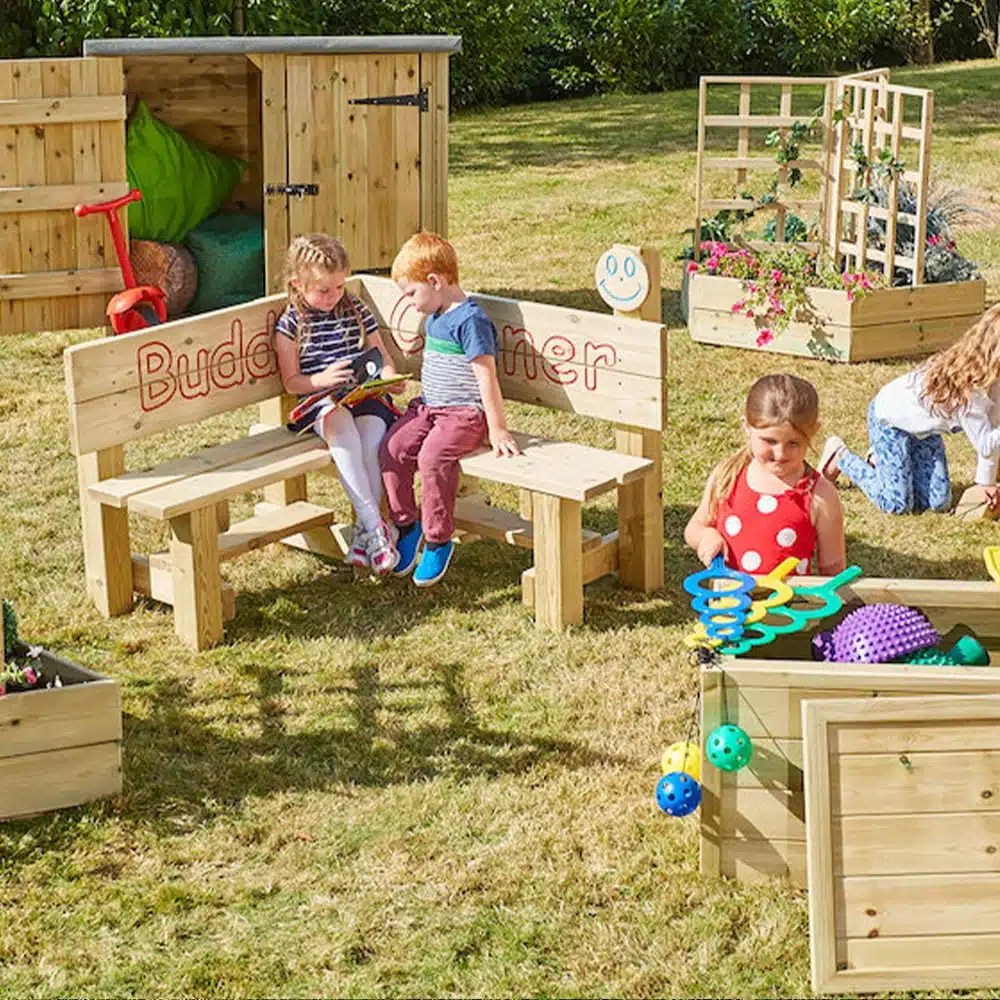

What Are The Best Ways To Incorporate Learning Activities into a Backyard Playground?
Incorporating learning activities into your backyard playground can enhance children’s cognitive and physical development. Here are some ideas to create an educational play environment:
- Outdoor Classroom: Set up an area with tables and seating where children can engage in educational activities like reading, writing, and art. This space can be used for structured lessons or free-form creative play, fostering a love for learning in an outdoor setting.
- Nature Exploration: Include elements encouraging children to explore and learn about nature. Install bird feeders, bug hotels, and butterfly gardens to attract wildlife. Provide magnifying glasses, binoculars, and field guides to help children observe and identify different species.
- Interactive Panels: Install educational panels and boards around the playground. These can include chalkboards for drawing and writing, weather stations to learn about the climate and sensory panels with different textures and sounds. Interactive panels make learning fun and accessible.
- Math and Science Games: Incorporate games and activities that teach math and science concepts. For example, a hopscotch grid can teach numbers and counting, while a sundial can demonstrate the movement of the sun and the idea of time. Use colorful and engaging designs to capture children’s interest.
- Musical Instruments: Outdoor musical instruments like drums, xylophones, and chimes can teach children about rhythm, pitch, and harmony. Music play encourages creativity and helps develop fine motor skills. Arrange the instruments in a musical garden for an immersive experience.
- Storytelling Areas: Create cozy nooks with benches or cushions where children can gather for storytelling sessions. Use natural elements like tree stumps or log seats to enhance the ambiance. Storytelling fosters language development and stimulates imagination.
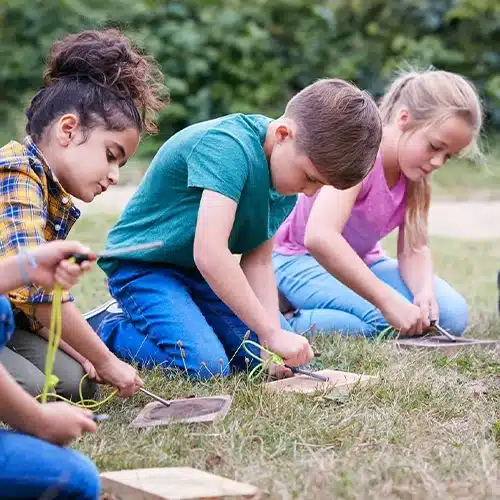


How to Select Equipment for Your Backyard Playground
Choosing the right equipment is crucial for creating a fun and safe playground. Here are some tips to help you make informed decisions:
- Assess Your Space: Measure your backyard to determine the available space. Consider the layout and existing structures to ensure ample room for children to play safely without overcrowding.
- Identify Age Groups: Think about the ages of the children who will be using the playground. Select equipment that is appropriate for their developmental stages. Younger children need safer, lower equipment, while older kids might prefer more challenging structures.
- Prioritize Safety: Look for equipment that meets safety standards and certifications. Check for rounded edges, non-toxic materials, and sturdy construction. Safety should always be the top priority when selecting playground equipment.
- Consider Versatility: Multi-functional equipment that offers various play options can maximize play value and space efficiency. For example, a playset with swings, slides, and climbing elements provides diverse activities in one structure.
- Focus on Quality: Invest in high-quality materials that can withstand outdoor conditions and heavy use. Durable materials like treated wood, metal, and high-quality plastic ensure the longevity and safety of the playground equipment. Quality products may have a higher upfront cost but save money on maintenance and replacements.
- Involve the Kids: Get input from the children who will use the playground. Ask them what activities they enjoy and what equipment they find exciting. Involving kids in decision-making ensures that the playground meets their interests and keeps them engaged.
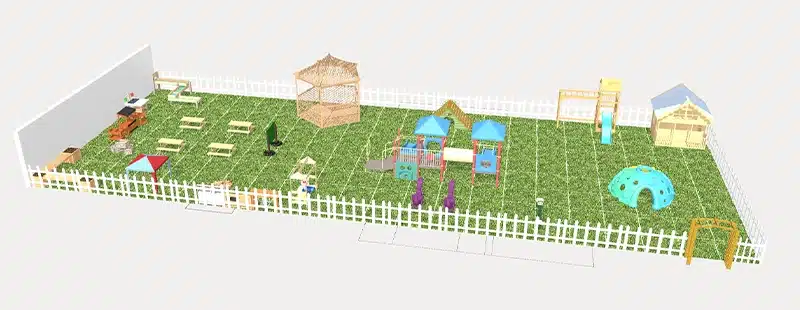
Creating a versatile and engaging backyard playground that caters to children of all ages is rewarding. Incorporating diverse equipment, adjustable features, and inclusive design ensures your outdoor space is a haven for fun and development. From toddler-friendly sandboxes to challenging climbing walls for older kids, there are countless ways to transform your backyard into a playground that grows with your children.
Ready to turn these backyard playground ideas into reality? Contact us today for customized playground solutions that meet your specific needs. Our team at Xiha Montessori is here to help you design and create the perfect play space for your children. Let’s build a backyard playground that inspires joy and adventure for years.
Send us your inquiry now, and let’s start planning your dream playground!
FAQs
1: What are the best backyard playground ideas for small outdoor spaces?
Even with limited space, you can create a highly functional and inspiring playground. Consider vertical elements like climbing walls, hanging activity panels, or compact swing sets. Dividing the yard into themed “mini-zones” — such as a reading nook, sandbox corner, and art station — allows for diverse play without overcrowding the area.
2: How can I make my backyard playground both fun and safe for children?
Choose age-appropriate, non-toxic materials, use rounded edges, and ensure secure installation of all equipment. Add safety surfacing like rubber mats, artificial grass, or wood chips beneath climbing structures. A well-zoned layout also helps reduce chaos and accidents, which is central to successful backyard playground ideas.
3: What are the most educational features I can include in my backyard playground?
Montessori- and Reggio-inspired ideas like garden beds, art stations, quiet nooks, and activity panels encourage sensory learning, independence, and creativity. Outdoor musical instruments and nature-based play areas also support developmental growth while keeping children actively engaged.
4: How do I maintain my backyard playground year-round?
Choose weather-resistant materials such as treated wood or heavy-duty plastic. Use modular furniture and storage units like wooden shelving or welly stores to protect toys and gear. During off-seasons, cover large structures and regularly inspect fixtures to ensure ongoing safety and durability.
5: How can backyard playground ideas support group play or classroom-style learning?
Design the space with defined zones — like a picnic area, sports zone, or outdoor classroom setup with freestanding stools and benches. Include structures like mud kitchens, pretend stores, and activity panels to encourage collaboration, role-play, and social development.
Conclusion
Designing the perfect outdoor environment doesn’t require a massive budget or a huge yard — it requires intention. From sensory-rich zones like sandboxes and music areas to practical additions like welly stores and wooden shelving units, the best backyard playground ideas balance fun, safety, learning, and flexibility. Whether you’re furnishing a kindergarten, planning a daycare, or creating an outdoor play space at home, a well-designed playground can inspire movement, creativity, and growth every single day. Start with your goals, define your zones, and build a space where children thrive — outdoors.

